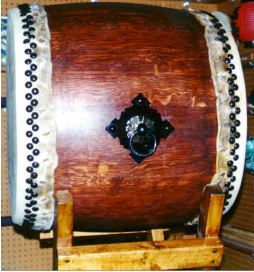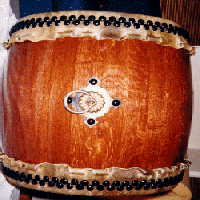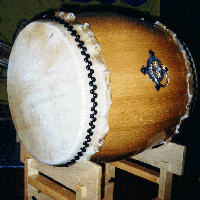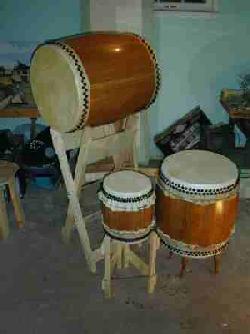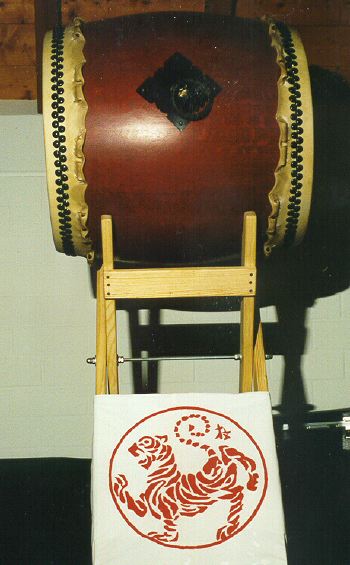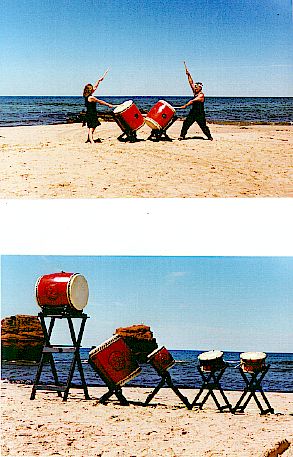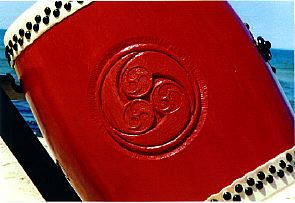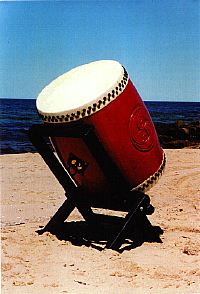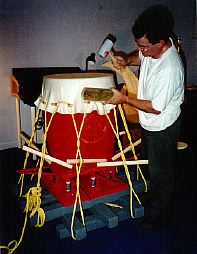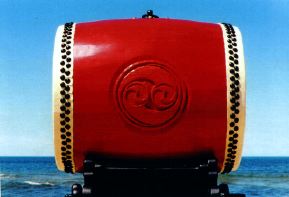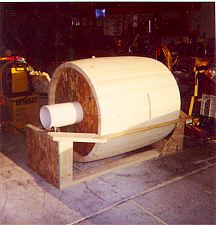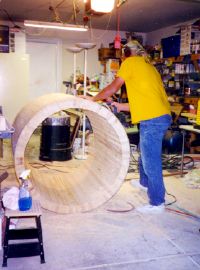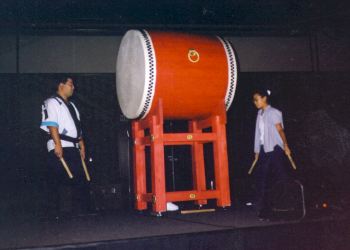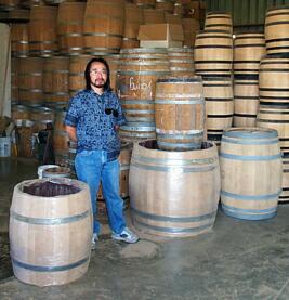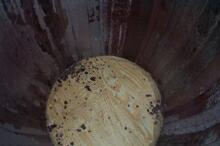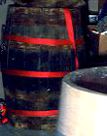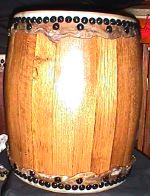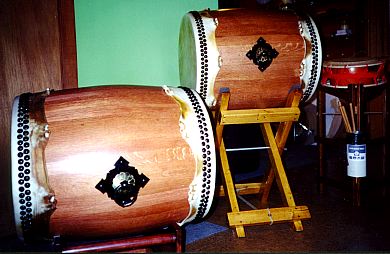|
|
This is one of my favorite taiko, it is also
the first one that I built. It is made from a French oak barrel, and the
dimensions are 22.5 inches diameter by 23 inches high. The 2 handles (medium
size-12 cm bracket), and the tacks are from Kawada
Taiko. I used Minwax red mahogany stain, and Minwax "helmsman"
exterior polyurethane. |
| Here is a look at some of the other taiko I
have made. The small taiko is 12 inches diameter by 17 inches high. The
barrel staves are probably made of douglas fir (not oak). I found it at
a garage sale for $10. It was painted with really ugly green paint, and
looked bad before I sanded it down. It is now enjoying a second life as
a taiko. |
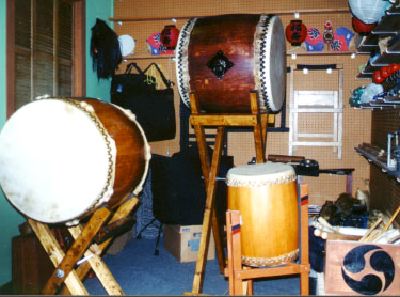
|
| One day just for fun, I decided to take the
12 by 17 inch taiko shown in the picture above, and rope the heads on it.
I followed the pattern from my Kawada
shimedaiko (shown right), and looped the rope through the skin and
then across the body. That part was not too hard to figure out. Next, I
had to learn how to loop and weave the rope around the middle of the body.
Pulling together the rope that holds the 2 skins on. After a few blisters,
I figured that part out. Then it just took a lot of muscle to tighten all
loops. This is actually a very old method of making a taiko. In Japan they
call this kind of taiko an "okedo." In buddhist ceremonies
it is known as a "nenbutsu daiko." |
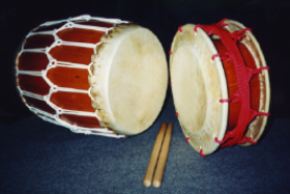
|
|
|
These 2 taiko were made by Dan Lindenmeyer,
of Seattle, Washington. Dan makes taiko under the name "World
Sphere Taiko." These 2 were made from French oak barrels; and
Dan makes the handles himself from brass and bronze. The tacks are from
Kawada Taiko. If you would
like to contact Dan about purchasing a taiko, you can contact Dan via e-mail.
|
| Joe Bowes, of Aromas, California
made the taiko pictured on the right. Joe has been making taiko and taiko
stands for the "Watsonville Taiko" group for several years.
Joe builds and sells his taiko under the name "Taiko Jo."
The taiko pictured is 24 inches in diameter, and made from a French oak
barrel. Joe uses tacks and handles from Kawada
Taiko. If you would like to contact Joe about purchasing a taiko,
please call him at (831) 726-1799. |
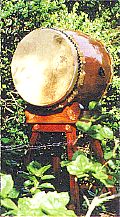
|
| Peter Mitchell of Edmonton,
Canada made this taiko. Peter is with "Kita
no Taiko" and has made many taiko for them. Peter uses materials
purchased from Kawada Taiko.
From the looks of his rig, he takes his taiko-making seriously. Peter has
a software design company with a web site: www.edm.shaw.wave.ca/~msd/
for those of you (like me) who are in the technology business. Well outside
of TAIKO of course. |
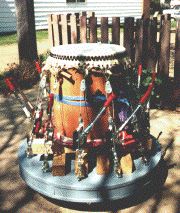
|
|
|
Steve Lein, who has made
some taiko for "Mu Daiko" of Minneapolis, made these 3 taiko for
his wife. This set of taiko has a nice range of sizes, and would make a
great "kumi daiko" setup. |
| This is one of four taiko I made in this size.
This taiko is 18.5 inches in diameter, by 22 inches in height. The barrel
came from the US rather than France, and there is a noticable difference
in the oak. The American oak barrel staves were rather rough, and did not
seem to be cured for very long. So even though this was a brand new barrel,
it took a lot of sanding to finish it. It also had to be reinforced carefully
on the inside since the staves had a tendency to "flex" while
I was working on it. I think this was due to the staves not being cured
long enough. One thing about a taiko this size, it is easy to move around.
It fits in any car, and through any door. It has a nice, rather high pitch
tone that complements my 22 inch diameter taiko, which has a deeper tone.
I used Watco medium walnut stain for the finish. |
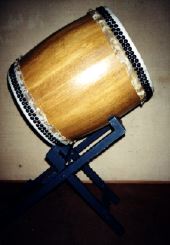
|
|
|
This O-daiko (left) was made by Rolf Hecking, of
Trier, Germany. Rolf is the taiko maker, and founding member of "Akatora
Taiko." Rolf uses tacks and handles from Kawada
Taiko. Rolf helped to translate the taiko making instructions
from our website into German. Looks like they are up to more than just
brewing beer and fahrvergnugen in Germany these days. Ausgezeichnet!
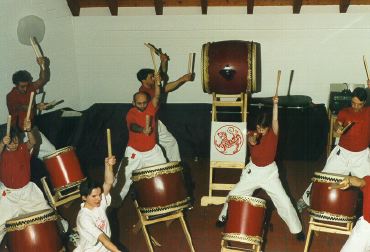
"Akatora Taiko" of Trier, Germany
|
| The "Don doko" taiko
made by Don Jagust of Tatsumaki Taiko. Don made this
taiko from a barrel purchased at "The Barrel
Shop," American Canyon, CA. The dimensions are 22 inches in
diameter by 25.5 inches high, which is standard for "nagadou"
taiko. The body was made from an excellent French oak wine barrel. The inside
was reinforced with plywood bands, the outside was finished with red mahogany
stain and 3 coats of "exterior" grade polyurethane. The taiko
has a pair of Kawada Taiko's
medium sized handles and was skinned using Kawada's medium size taiko tacks.
Most importantly, this taiko kicks butt! It is really loud and packs
a lot of punch. It is great to play on a flat stand, down low for "Miyake
Daiko," or on a tall "X-dai" for "O-daiko." |
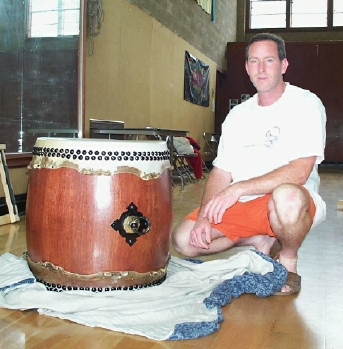
|
|
|
Takashi of Tatsumaki Taiko at "The Barrel
Shop" standing next to his future nagadou taiko (left) and our
new O-daiko (right). Ron Young (owner) did an excellent job putting together
the staves for our new taiko. Check our FAQs page
for more information about "The Barrel Shop." |
| My son Bryan, trying out the "Ofuro - O-daiko."
Not sure if it would make a better hot tub or O-daiko?? The body of our
O-daiko was made from a puncheon barrel, which is about the largest barrel
generally available to DIY taiko builders. Our O-daiko measures 32 inches
in diameter by 34 inches in length, and just barely fits through my basement
door. |
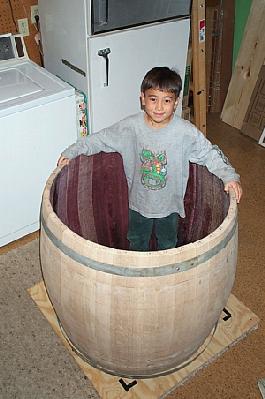 |
|
|
A picture of the inside of the O-daiko barrel before being
scraped and brushed clean with a stiff bristle wire brush. Used barrels
frequently have residue caked on the inside of the staves. I have found
that this is removed more easily after being allowed to dry. I used a wire
brush, a handheld paint scrapper, and a paint-stripper attachment on an
electric drill to clean off the residue. |
| The O-daiko body after being glued and banded on the inside.
The plywood bands help to reinforce the outside edges, as well as the middle
of the staves where the handles will be attached. I had to put the body
on a dolly so I could move it around while working on it. In this picture
I just started the first sanding using a belt-sander with 80 grit paper.
The staves didn't require as much heavy sanding since I used a biscuit joiner
to form the body. The biscuits helped the staves line-up more closely, so
there was less sanding needed to smooth the body into shape. |
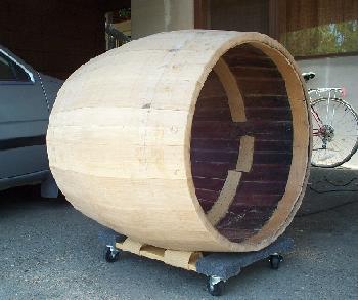 |
|
|
The next 4 pictures show the metamorphosis of a barrel into a taiko. The barrel pictured at left, came from the Berkeley Recycling Center, it looked pretty hopeless when I first started working on it. I almost gave up on this barrel ever becoming a taiko - it looked so bad! The barrel staves were extremely water damaged, and had rust stains on them. However, they are made of oak, and oak is a very forgiving wood. Oak can be worked with as long as it is not rotten through. Here is proof that one man's trash is another's taiko.
|
|
This picture shows the same barrel above after it has been cut to size, glued, and banded on the inside. Here it is being rough sanded, and inspected by my toughest critic - my son. The dimensions worked out to be 14 inches in diameter by 17.5 inches high. Considering I bought this barrel for $10, it was not a bad bargain after all. After sanding it down, I discovered there really was a taiko hiding beneath the dirt and rust.
|
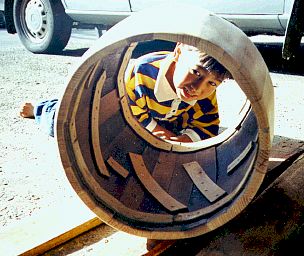
|
|
The same small taiko shown above, but after being finished. I used Watco medium walnut stain, and Minwax "helmsman" exterior polyurethane. Note that a lighter stain such as walnut tends to show the stave lines. (Compare to the picture of the large taiko at the top of the page, stained with red mahogany which tends to hide the staves).
|
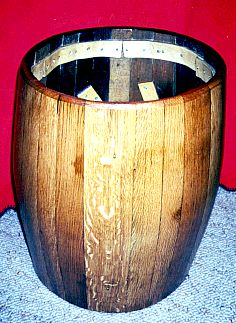
|
|
|
The complete metamorphosis of a barrel into a taiko. This taiko came out better than I expected considering its humble beginnings. It has a nice high pitch, and works well in a "kumi daiko" set, complementing my other larger taiko and shimedaiko.
|
|
This is a pair of taiko that I completed just before New Year's 2000. They are both 19.5 inches in diameter, by 25 inches high and made from French oak wine barrels. The first picture shows them cut and rough sanded.
|
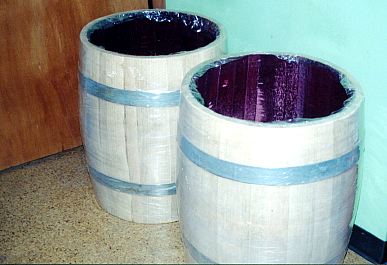
|
|
|
Here are the same 2 barrels -- now re-born as taiko -- complete
with handles and skinned (using Kawada
Taiko's medium handles, and small taiko tacks). I used Minwax red
mahogany stain, and Minwax "helmsman" exterior polyurethane for
the finish. |
